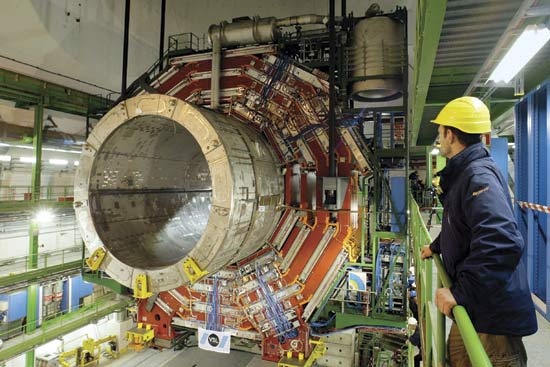colliding-beam storage ring
device
also called collider
 type of cyclic particle accelerator that stores and then accelerates two counterrotating beams of charged subatomic particles (subatomic particle) before bringing them into head-on collision with each other. Because the net momentum of the oppositely directed beams is zero, all the energy of the colliding beams is available to produce very-high-energy particle interactions. This is in contrast to interactions produced in fixed-target particle accelerators, in which a beam of accelerated particles strikes particles in a stationary target and only a fraction of the beam energy is transformed into the particle interaction energy. (Most of the beam energy is converted to kinetic energy in the products of the collision, in accordance with the law of conservation of momentum (momentum, conservation of).) In a collider the product or products can be at rest, and virtually all of the combined beam energy is therefore available for new-particle creation via the Einstein mass-energy relation (Einstein's mass-energy relation). The hunt for massive subatomic particles—for example, the W (W particle) and Z carrier particles (Z particle) of the weak force or the “top” quark—has been successful because of the construction of powerful colliding-beam storage ring particle accelerators such as the Large Electron-Positron (LEP) collider at the European Organization for Nuclear Research ( CERN) in Geneva and the Tevatron at the Fermi National Accelerator Laborator (Fermi National Accelerator Laboratory)y (Fermilab (Fermi National Accelerator Laboratory)) in Batavia, Illinois.
type of cyclic particle accelerator that stores and then accelerates two counterrotating beams of charged subatomic particles (subatomic particle) before bringing them into head-on collision with each other. Because the net momentum of the oppositely directed beams is zero, all the energy of the colliding beams is available to produce very-high-energy particle interactions. This is in contrast to interactions produced in fixed-target particle accelerators, in which a beam of accelerated particles strikes particles in a stationary target and only a fraction of the beam energy is transformed into the particle interaction energy. (Most of the beam energy is converted to kinetic energy in the products of the collision, in accordance with the law of conservation of momentum (momentum, conservation of).) In a collider the product or products can be at rest, and virtually all of the combined beam energy is therefore available for new-particle creation via the Einstein mass-energy relation (Einstein's mass-energy relation). The hunt for massive subatomic particles—for example, the W (W particle) and Z carrier particles (Z particle) of the weak force or the “top” quark—has been successful because of the construction of powerful colliding-beam storage ring particle accelerators such as the Large Electron-Positron (LEP) collider at the European Organization for Nuclear Research ( CERN) in Geneva and the Tevatron at the Fermi National Accelerator Laborator (Fermi National Accelerator Laboratory)y (Fermilab (Fermi National Accelerator Laboratory)) in Batavia, Illinois.The basic structural element of most colliders is a synchrotron (accelerator) ring. The early collider projects—for example, the Intersecting Storage Rings (ISR) proton-proton collider, which operated at CERN in the 1970s—were built to collide beams of identical particles and so required two synchrotron rings that were interlaced to bring the beams into collision at two or more points. Two synchrotron rings are also required if the colliding beams contain particles of different mass, such as at the electron-proton collider that began operation in 1992 at DESY (German Electron Synchrotron) in Hamburg, Germany.
A single synchrotron ring can accommodate two beams of particles traveling in opposite directions, provided the two beams contain particles having the same mass but opposite electric charge—that is, if the beams consist of a particle and its antiparticle, for example, an electron and a positron or a proton and an antiproton. Bunches of each type of particle are injected into the synchrotron ring from a preacceleration source. Once a sufficiently large number of particles has accumulated in each beam, the two beams are accelerated simultaneously until they reach the desired energy. The beams are then brought into collision at predetermined points surrounded by particle detectors. Actual interactions between particles are relatively rare (one of the drawbacks of colliding-beam systems), and the beams can typically circulate, colliding on each circuit, for several hours before the beams are “dumped” and the machine “filled” once again.
Fermilab is the site of the Tevatron, the world's highest-energy proton-antiproton collider, which began operation in 1985 and delivers particle beams at energies of 900 gigaelectron volts (GeV) per beam to produce total collision energies of 1,800 GeV (equivalent to 1.8 teraelectron volts, TeV). CERN operates the world's largest collider ring, with a circumference of 27 km (17 miles). From 1989 to 2000 the ring contained the LEP collider, which was able to reach a maximum energy of 100 GeV per beam. A much-higher-energy collider, the Large Hadron Collider (LHC), which began test operations at CERN in 2008, replaced the LEP collider in the 27-km ring. The LHC project is designed to bring about collisions between two proton beams or between beams of heavy ions, such as lead ions. As a proton-proton collider, the LHC is expected to deliver a total collision energy of approximately 14 TeV. The large 27-km synchrotron tunnel is occupied by superconducting magnets and houses two separated beam lines with opposite magnetic fields to accommodate collisions between beams of identical particles.
- Coornhert, Dirck Volckertszoon
- Coos
- Coosa River
- Coos Bay
- coot
- Cootamundra
- Coote, Sir Eyre
- Cootie Williams
- Coover, Robert
- Copacabana
- copal
- cope
- sporophyte
- sporotrichosis
- sports
- Sports, Book of
- sports-car racing
- sports medicine
- spotlight
- Spotswood, Alexander
- Spotsylvania Court House, Battle of
- Spotted Tail
- spotted turtle
- Sprague, Kate Chase
- sprain